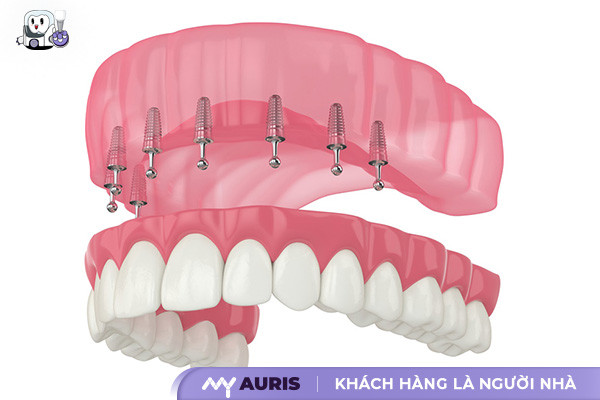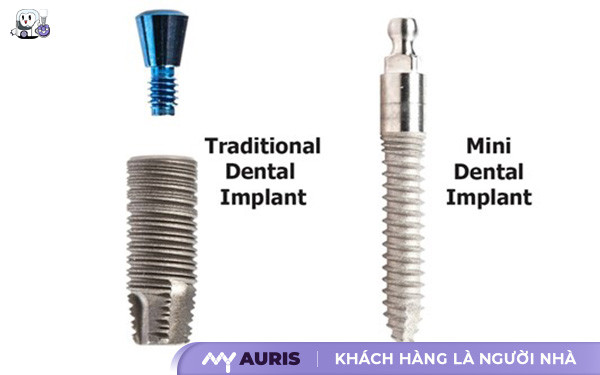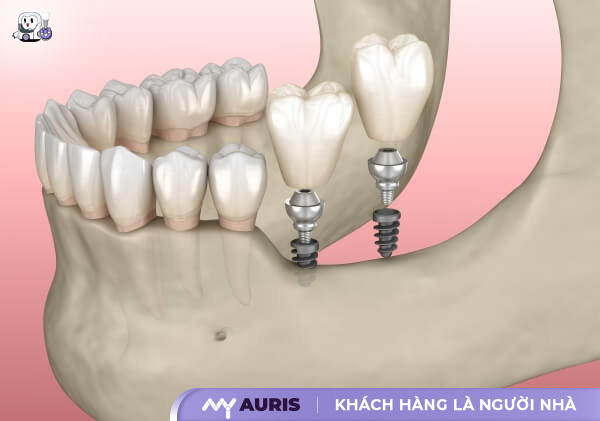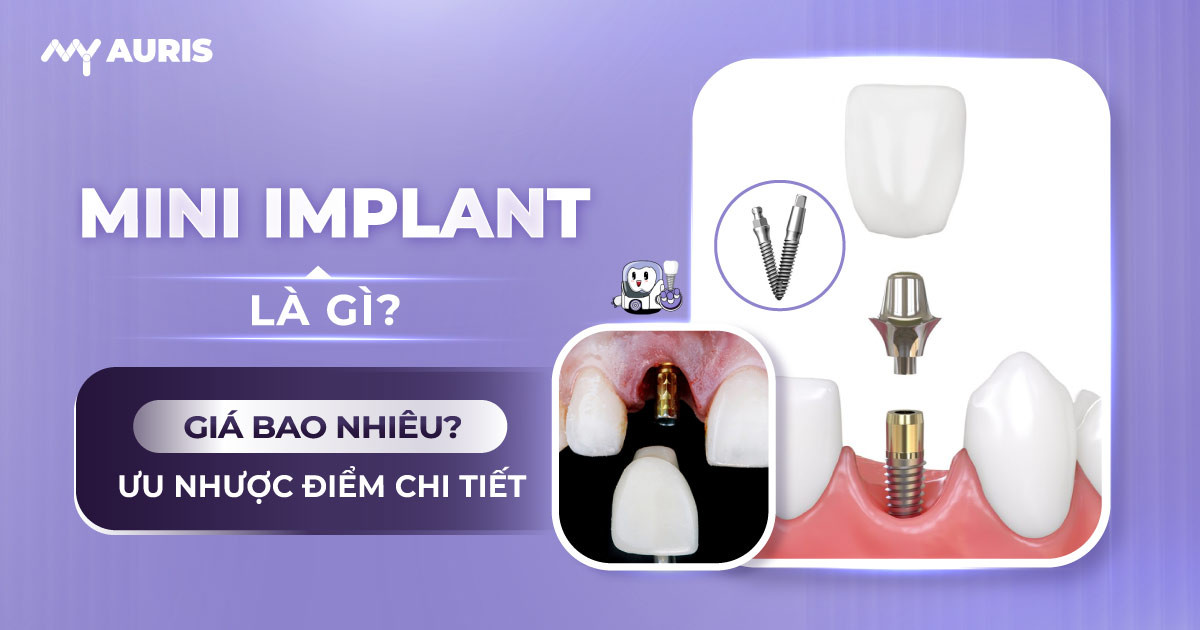Compared to traditional implants, mini implants are smaller, less invasive, and cost less. So, what exactly are mini implants? When should one opt for mini implants? This article by My Auris will provide a detailed analysis of mini implants, compare them with traditional implants, and offer a reference price list.
What is a Mini Implant?
A Mini Implant is a miniaturized version of a traditional dental implant, boasting a significant advantage in implant size. Thanks to its small diameter (only about 2.0 – 3.0mm) and implant length of 8.0 – 12mm, Mini Implants are highly suitable for placement in narrow areas of the jawbone – places where traditional implants are often difficult to deploy. With its streamlined design, this type of post still effectively supports artificial teeth and can withstand moderate chewing forces, helping patients chew more stably and comfortably.

Standard Structure of a Mini Implant
Despite its smaller size, the Mini Implant post still retains the basic three-part structure of a traditional implant post:
Implant Post: This is the part directly embedded into the jawbone.
Abutment: The connector between the post and the artificial tooth.
Porcelain Crown: The restorative tooth part placed on top, ensuring aesthetics and chewing function.
With these advancements in implant size, Mini Implants not only shorten treatment time but also minimize surgical intervention, making them ideal for individuals with weak jawbones or those who wish to avoid bone grafting.

Comparison of Mini Implants and Traditional Dental Implants
Mini Implants are an ideal choice for cases where the jawbone is thin or not suitable for placing larger posts. With a diameter of only about 2 – 3mm and a length ranging from 8 – 12mm, mini implants are nearly half the size of traditional implants, making the implant placement process simpler and less invasive.
The cost of a mini implant is typically significantly lower than that of a traditional implant post. This is because the smaller implant size simplifies the manufacturing process for the post and reduces many steps in the implantation technique, providing clear economic benefits for users.
Thanks to their minimalist design and less complex implantation technique, mini implants typically have a faster healing time. This is a major plus for those who need tooth restoration in a short period and wish to return to normal activities quickly.
Despite their many advantages, it’s important to note that mini implants have a lower load-bearing capacity compared to traditional implants. Therefore, if using mini implants, users should limit consuming overly hard or chewy foods to avoid applying excessive pressure and damaging the post. For restorative cases requiring high load-bearing capacity, dentists typically recommend choosing larger implant posts.

When Should You Choose Mini Implants?
The use of Mini Implants is suitable in specific situations to ensure aesthetics, cost-effectiveness, and high treatment efficacy. Here are typical cases:
During the waiting period for porcelain tooth restoration, dentists may suggest using Mini Implant posts to support temporary dentures, allowing patients to maintain normal daily activities without affecting aesthetics or chewing function.
Mini implants are an ideal choice for restoring front teeth – positions that do not require strong chewing forces. Additionally, if the tooth gap is too narrow, making traditional implant placement difficult, the compact Mini Implant post will be an effective solution.
For cases where patients do not wish to undergo bone grafting before implant placement, dentists may consider using Mini Implants to ensure treatment is not overly invasive while still achieving the desired outcome.
If a patient has experienced long-term tooth loss, leading to jawbone resorption and insufficient volume to support a large post, Mini Implants can help restore chewing function and prevent further bone loss.
How much does a mini implant cost?
On average, the cost of Mini Implant placement ranges from approximately 10 million to 15 million VND per post. This price may vary depending on the type of implant post, implant origin, technology used, and accompanying services. For a detailed quote, users should consult directly with specialized dental clinics.
Price List of Some Popular Implant Post Types by Origin at My Auris
| Implant Post Type | Unit | Price Range
(VND) |
Healing Time | Warranty |
| Biotech Korea | 1 set | 12.250.000 | 6 months | 10 years |
| Biotech Premium Korea | 1 set | 15.500.000 | 3 – 6 months | 15 years |
| Dentium Korea | 1 set | 19.600.000 | 3 -6 months | 20 years |
| Dentium USA | 1 Set | 35.000.000 | 2 – 4 months | 30 years |
| HIOSSEN USA | 1 set | 28.500.000 | 2 months | 50 years |
| Zimmer Biomet USA | 1 set | 70.000.000 | 3 weeks | Lifetime |
| SIC Switzerland | 1 set | 40.000.000 | 2 months | Lifetime |
| Straumann Switzerland | 1 set | 45.000.000 | 2 months | Lifetime |
Standard 5-Step Medical Implant Placement Process: Safe and Effective
Dental implant placement is an optimal solution for restoring lost teeth, both in terms of function and aesthetics. Below is a 5-step in-depth implant placement process, ensuring absolute precision and safety:
Step 1: General Examination and Implant Consultation
Before implant placement, you need to undergo a general oral and systemic health check. The dentist will perform a 3D CT scan to assess your jawbone, the missing tooth position, and suitability for implant placement. Concurrently, necessary tests will be conducted to ensure you meet the health requirements for the procedure. After the results are available, the dentist will provide a detailed implant consultation regarding the treatment plan, suitable implant type, and the cost of dental implant placement.
Step 2: Implant Post Placement
Before the post is placed, you will undergo a final health check and receive local anesthesia in the treatment area to ensure a pain-free implantation process. The implant post placement procedure is quick, typically taking only 7 – 10 minutes, minimizing invasiveness and providing comfort to the patient.
Step 3: Impression Taking and Temporary Tooth Placement
Approximately 2 – 3 days after post placement, you will return for the dentist to take impressions and place a temporary tooth, ensuring normal eating and drinking activities while the bone heals.
Step 4: Follow-up Examination to Check Healing Progress
7 – 10 days after implant placement, you need to visit the center for a follow-up examination. The dentist will assess the healing status of your gums and jawbone, ensuring stable integration of the post.
Step 5: Attaching the Porcelain Crown to the Post and Fixing with a Connector
Once the jawbone has firmly integrated with the post, the dentist will proceed to attach the porcelain crown to the post via a connector, completing the new tooth in terms of shape and function. Finally, you will receive thorough instructions on at-home oral care to maintain the long-term durability and health of your implant tooth.
Pros and Cons of Mini Implants
Advantages of Dental Mini Implants
The Mini Dental Implant placement method is increasingly popular due to its simplicity and effectiveness. The procedure is gentle, does not require flap surgery, thus being less invasive and causing no pain throughout the process of placing the compact implant post into the jawbone.
A significant strength is its rapid healing ability, which helps patients – especially the elderly or those with weakened health – easily restore chewing function in a short period. As a result, customers can resume normal activities without difficulty in eating.
Another advantage of Mini Implants is their reasonable cost. Due to their small size and uncomplicated procedure, the price is much lower compared to traditional implant-supported dental restorations. This expands access to the service for a wider range of individuals.
Notably, Mini Implants are an ideal choice for individuals with low jawbone density, who are not suitable for standard implant placement. Furthermore, mini posts help stabilize dentures, ensuring long-term durability and chewing effectiveness.
With a simple procedure and an almost absolute success rate, Mini Implants are becoming an optimal solution in the dental implant industry today.

Disadvantages to Note
While possessing many outstanding features, Mini Implants also have some limitations. Due to the small size of the implant post, its load-bearing capacity will not be as high as that of a traditional post. When chewing hard foods or those requiring strong biting forces, there is still a risk of affecting the post, especially if the jawbone is weak.
Furthermore, this method is only suitable for certain positions in the dental arch. If applied to molar positions, the chewing effectiveness may not be as expected due to the typically strong chewing forces in that area.





